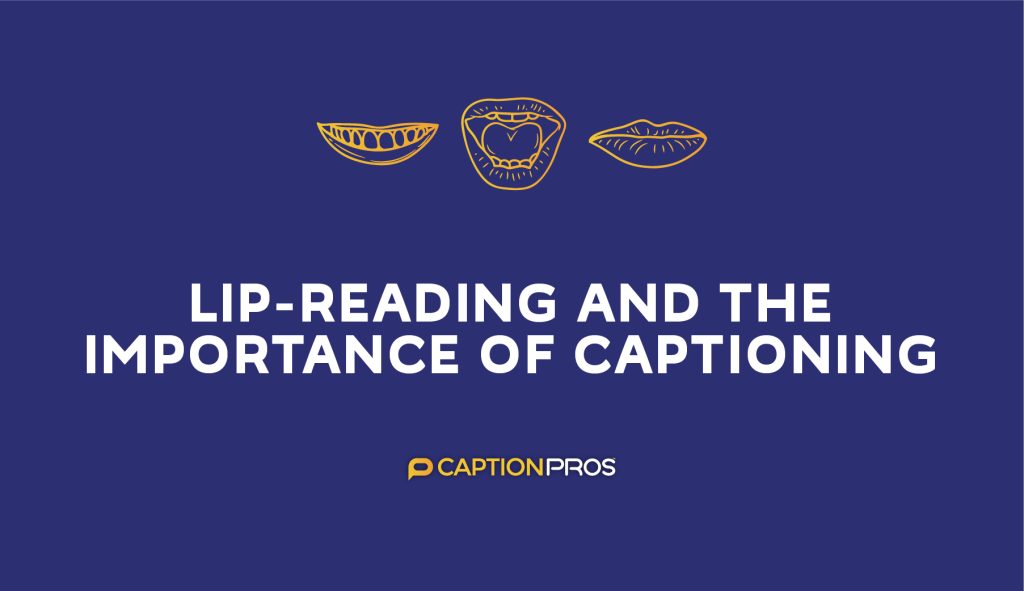Lip Reading and the Importance of Captioning
The number one rule of communicating with individuals who have hearing loss: don’t make assumptions. Just as no two people have the exact same preferences in food or music, the people you meet have preferences in how they’d like their interactions to go. Despite this, many people continue to assume that all people who are d/Deaf or hard-of-hearing can lip-read.
What’s easiest isn’t necessarily best!
Lip reading is a wonderful tool! It enables hearing persons to communicate in a way they are used to and doesn’t require them to learn sign language or write their words down. It even allows us to watch other people’s conversations! However, it puts all the pressure on the person who is receiving the communication. Accommodations are not for the convenience of the abled and hearing; they mean adjusting society so that marginalized members can feel included.
Of course, we have just lived through an enormous obstacle in the face of lip reading: masks being worn by everyone. Those dark days are almost over, but plenty of other things can hinder the ability to read lips.
Lip reading can be a challenge.
Whispering and mumbling words, covering mouths, and talking while chewing gum can become obstacles to accurate interpretations. Speaking to someone with a different dialect can also make things difficult, as their lips tend to move in different ways and exaggerate different syllables. If you’ve ever seen a bad lip reading dub video, you know how easily messages can be misunderstood with only visual cues to go off of. Very few people would want to sign up for constantly interpreting facial movements. So please don’t assume it’s simple and easy to pick up!
It’s all about preference when it comes to lip reading.
Some people rely almost entirely on lip-reading, and others don’t have the desire to learn at all. It’s just personal preference, and both of these options are equally valid. The ability to read lips isn’t the simple task people make it out to be – in fact, only 30 to 45 percent of language can be deciphered by lip-reading alone. Not even the most skilled lip readers who’ve had decades of practice can perfect their ability. Picture a conversation in which you receive less than half of the information you need and have to piece together the rest through context and body language. Exhausting, isn’t it?
How can we make lip reading easier?
The best way to figure out someone’s preferred method of communication, much like with any other preference, is to simply ask. To make lip reading easier, avoid talking fast and be sure to annunciate rather than mumble. If someone is having a hard time understanding, don’t brush them off. Disregarding the misunderstanding makes them feel excluded from the hearing world. Instead, rephrase, or write the words down. There are many great tools available to assist in conversation, such as a communication access real-time translator (CART). It translates your spoken words into text the other person can read, much like using voice commands to send text messages.
The world needs captions.
Advancements in technology have given us a range of options through which we can communicate. What d/Deaf and hard-of-hearing people want is understanding and patience from the hearing community and consideration of their needs. Captions have provided accessibility for several genres of media. Not everyone can rely on lip-reading to figure out what is being said on live streams and movies. Even if they could, lip-reading wouldn’t work on animation films. Imagine trying to lip-read Finding Nemo. That wouldn’t work well.
Captions also provide knowledge of contextual sounds that lip reading cannot, such as crashing noises, doors slamming, and guns firing. They also capture the words of characters speaking off-screen and occasionally the tone of voice (sarcasm, annoyance, excitement) that might be vital to storytelling.
We fill in the gaps!
Whether or not someone can hear doesn’t mean they don’t deserve to experience movies and videos in the same way. Providing several forms of accommodation is the best way we can support the d/Deaf and hard-of-hearing. Whether through sign language, lip-reading, captions, or any combination of methods, everyone has a preferred mode of understanding the world around them. Reading is a much more natural process to many people than learning hand signs or lip reading.
Be an advocate
Several forms of entertainment still lack a way for those with hearing loss to understand what’s happening outside of lip reading. Plays, comedy clubs, streaming services, sporting events, and other events often need live captioning. Being an advocate means pointing out a lack of accessibility in public spaces. Now that you’re aware of many of the pitfalls of lip-reading communication, it will be easier to understand the need for captioning in all sorts of media. Advocating for captions is advocating for accessibility! Get in touch with us at Caption Pros to learn more.







